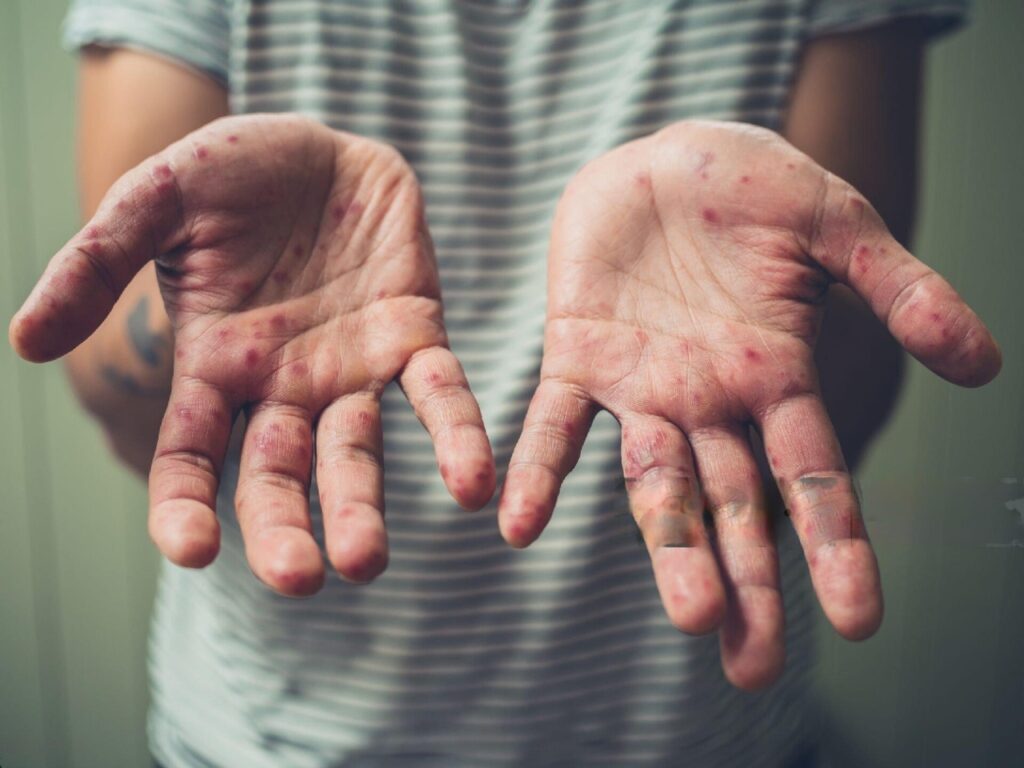Chickenpox, scientifically known as Varicella, is a highly contagious viral infection that primarily affects children but can also occur in adults. This disease, caused by the varicella-zoster virus (VZV), typically results in an itchy rash, fever, and fatigue. While chickenpox was once a common childhood illness, the introduction of the varicella vaccine has significantly reduced its prevalence. However, understanding the nature of chickenpox and how to prevent it remains crucial for public health.
What is Chickenpox Know All About it

Understanding Chickenpox: A Closer Look
Chickenpox is a viral infection caused by the varicella-zoster virus (VZV), a member of the herpesvirus family. It is characterized by a distinct rash that progresses through several stages, making it one of the most recognizable illnesses in the world. Understanding the nature of chickenpox is crucial for recognizing its symptoms, managing its effects, and preventing its spread.
The Varicella-Zoster Virus: An Overview
The varicella-zoster virus is highly contagious and primarily spreads through direct contact with the rash or through airborne transmission via respiratory droplets. The virus can remain dormant in the body for years, reactivating later in life to cause shingles, a painful condition that affects the nerves. The dual nature of this virus highlights the importance of early vaccination and awareness of the symptoms.
Stages of the Chickenpox Rash
The chickenpox rash is a hallmark of the disease and undergoes several stages, each with distinct characteristics:
- Macules: The rash begins as flat, red spots called macules. These appear in clusters on the face, scalp, chest, and back, gradually spreading to the rest of the body. The number of spots can vary widely, ranging from a few dozen to several hundred.
- Papules: Within a few hours to a day, the macules develop into raised bumps known as papules. These papules are often itchy and can cause significant discomfort, particularly in young children.
- Vesicles: The papules then transform into vesicles, which are small, fluid-filled blisters. These blisters are usually clear but may become cloudy as the disease progresses. The vesicular stage is when the rash is most contagious, as the fluid inside the blisters contains a high concentration of the virus.
- Crusts and Scabs: After a few days, the vesicles begin to dry out, forming crusts or scabs. The scabs eventually fall off, typically without leaving permanent scars, unless the blisters have been scratched and become infected.
Systemic Symptoms of Chickenpox
In addition to the rash, chickenpox often presents with systemic symptoms that can affect the entire body:
- Fever: A mild to moderate fever usually accompanies the onset of the rash. In adults, the fever may be higher and last longer, reflecting the more severe nature of the illness in older individuals.
- Fatigue and Weakness: Patients often experience a general feeling of malaise or weakness, which can persist for several days. This fatigue is partly due to the body’s immune response to the infection.
- Loss of Appetite: Many individuals with chickenpox experience a reduced appetite, particularly during the early stages of the illness. This symptom is common in viral infections and typically resolves as the patient begins to recover.
- Headache and Muscle Aches: Headaches and muscle pain are also common, adding to the overall discomfort caused by the disease. These symptoms can vary in intensity, with some patients experiencing mild aches and others suffering from more severe pain.
The Immune Response to Chickenpox
When the body is infected with the varicella-zoster virus, the immune system responds by producing antibodies to fight the infection. These antibodies help clear the virus from the bloodstream, leading to the resolution of symptoms. However, the virus can remain dormant in nerve cells, potentially reactivating later in life as shingles.
The immune response to chickenpox also provides long-term immunity in most cases, meaning that once a person has had chickenpox, they are unlikely to get it again. This immunity is one of the reasons why chickenpox is less common in adults, as most individuals contract the virus during childhood.
Chickenpox in Different Populations
The presentation and severity of chickenpox can vary depending on the age and health of the individual:
- Children: Chickenpox is generally milder in children, with a lower risk of complications. However, it can still cause significant discomfort and missed school days. Children who are immunocompromised or have other underlying health conditions are at higher risk for severe disease.
- Adults: Adults who contract chickenpox are more likely to experience severe symptoms and complications, such as pneumonia or encephalitis. This increased risk underscores the importance of vaccination for adults who have never had chickenpox or the vaccine.
- Pregnant Women: Chickenpox during pregnancy can lead to serious complications for both the mother and the baby. Congenital varicella syndrome, a rare condition, can cause birth defects if the mother contracts the virus during the first 20 weeks of pregnancy. Pregnant women who have never had chickenpox or the vaccine should avoid exposure to the virus and seek medical advice if exposed.
- Immunocompromised Individuals: Those with weakened immune systems, such as cancer patients or individuals with HIV, are at a much higher risk for severe complications from chickenpox. In these cases, the virus can spread to internal organs, leading to life-threatening conditions.
Understanding the various aspects of chickenpox, from its stages and symptoms to its impact on different populations, is essential for effective prevention and treatment. With widespread vaccination and awareness, the burden of this once-common disease can be significantly reduced.
How Chickenpox Spreads
Chickenpox, caused by the varicella-zoster virus (VZV), is highly contagious and spreads easily from person to person. The virus can be transmitted through multiple routes, making it a significant public health concern, especially before the widespread use of the varicella vaccine. Understanding how chickenpox spreads is crucial for preventing outbreaks and protecting vulnerable populations.

Modes of Transmission
Chickenpox primarily spreads through two main modes of transmission: direct contact and airborne transmission.
- Direct Contact with the Rash: The most common way chickenpox spreads is through direct contact with the fluid from the blisters on an infected person’s skin. The virus is present in the vesicles of the rash, and any contact with these can transfer the virus to another person. This form of transmission is particularly risky for individuals who touch their eyes, nose, or mouth after coming into contact with the rash, as the virus can easily enter the body through mucous membranes.
- Airborne Transmission: Chickenpox can also spread through the air, making it highly contagious in settings where people are nearby. When an infected person coughs, sneezes, or even talks, tiny respiratory droplets containing the virus are expelled into the air. These droplets can be inhaled by others, leading to infection. The virus can remain suspended in the air for some time, increasing the likelihood of transmission in enclosed spaces such as schools, homes, and daycare centers.
The Contagious Period
The contagious period of chickenpox is a critical aspect of its spread. A person with chickenpox becomes contagious 1 to 2 days before the appearance of the rash and remains contagious until all the blisters have crusted over. This period usually lasts about 7 to 10 days, during which the virus can easily spread to others.
- Before the Rash: The fact that a person can spread chickenpox before the rash appears makes it particularly challenging to control. During this pre-rash period, the infected person may feel unwell with symptoms like fever, headache, or fatigue, but without the visible signs of chickenpox, they may not realize they are contagious.
- During the Rash: Once the rash appears, the risk of transmission increases, especially as the vesicles break open, releasing virus-laden fluid. The person is most contagious at this stage, and contact with the fluid or respiratory droplets can easily spread the virus to others.
- After the Rash Crusts Over: The contagious period ends when all the blisters have crusted over and no new lesions are forming. At this point, the risk of spreading the virus drops significantly, and the individual is no longer considered contagious.
High-Risk Settings for Transmission
Certain environments and conditions can increase the likelihood of chickenpox transmission:
- Households: Close family members are at high risk if one person in the household contracts chickenpox. The shared living space and frequent contact create an ideal environment for the virus to spread. Secondary attack rates within households can be as high as 90%.
- Schools and Daycare Centers: Children in schools and daycare centers are particularly susceptible to chickenpox outbreaks due to the close quarters and frequent interaction among students. Airborne transmission in these settings is common, and the virus can spread rapidly before preventive measures can be implemented.
- Healthcare Settings: Hospitals and clinics can be high-risk environments, particularly for immunocompromised patients. Healthcare workers who are not immune to chickenpox need to take special precautions, as they can inadvertently spread the virus to vulnerable patients.
Risk Factors for Transmission
Several factors can increase the risk of chickenpox transmission:
- Lack of Immunity: Individuals who have never had chickenpox or the varicella vaccine are at the highest risk of contracting the virus. This includes young children who are too young to be vaccinated, adults who were never exposed to the virus as children, and individuals who were not vaccinated during childhood.
- Immunocompromised Individuals: People with weakened immune systems, such as those undergoing chemotherapy, organ transplant recipients, or individuals with HIV, are at higher risk for contracting chickenpox and experiencing severe complications. Their immune systems may not be able to fight off the virus as effectively, leading to more serious illness.
- Pregnant Women: Pregnant women who are not immune to chickenpox are at risk of severe complications if they contract the virus. Chickenpox during pregnancy can lead to congenital varicella syndrome in the fetus, which can cause birth defects. Pregnant women should avoid contact with anyone known to have chickenpox.
Prevention of Spread
Preventing the spread of chickenpox involves a combination of vaccination and practical measures:
- Vaccination: The varicella vaccine is the most effective way to prevent chickenpox. It is recommended for children, adolescents, and adults who have never had chickenpox or the vaccine. Two doses of the vaccine provide strong protection against the virus.
- Isolation of Infected Individuals: Those who have chickenpox should stay home from school, work, and public places until all their blisters have crusted over. This reduces the risk of spreading the virus to others, particularly in high-risk environments.
- Good Hygiene Practices: Regular handwashing, covering the mouth and nose when coughing or sneezing, and avoiding touching the face can help prevent the spread of chickenpox. These practices are especially important in settings where people are in close contact, such as schools and healthcare facilities.
- Avoiding Contact with Infected Individuals: Individuals who are not immune to chickenpox should avoid close contact with those known to be infected. This is particularly important for pregnant women, newborns, and immunocompromised individuals.
Understanding how chickenpox spreads and taking proactive measures to prevent its transmission are key to controlling outbreaks and protecting vulnerable populations. Through vaccination, awareness, and responsible behavior, we can significantly reduce the impact of this contagious virus.
Complications Associated with Chickenpox
While chickenpox is generally mild, it can lead to severe complications, particularly in certain high-risk groups. These complications can include:

- Bacterial infections: The skin lesions caused by chickenpox can become infected with bacteria, leading to conditions like cellulitis or impetigo.
- Pneumonia: This is more common in adults and can be life-threatening.
- Encephalitis: An inflammation of the brain that can result in seizures, headaches, or even coma.
- Reye’s Syndrome: A rare but serious condition that causes swelling in the liver and brain, particularly when aspirin is used to treat chickenpox symptoms in children.
- Shingles: Later in life, the varicella-zoster virus can reactivate in the body, causing shingles, a painful rash.
Preventing Chickenpox: Vaccination is Key
The most effective way to prevent chickenpox is through vaccination. The varicella vaccine is highly effective and is recommended for all children, adolescents, and adults who have not had chickenpox or been vaccinated. The vaccine is typically given in two doses: the first at 12 to 15 months of age and the second at 4 to 6 years of age. For those who miss these vaccinations during childhood, catch-up doses are recommended.

Herd Immunity and Vaccination
Widespread vaccination not only protects individuals but also contributes to herd immunity, reducing the overall spread of the virus in the community. This is especially important for protecting those who cannot be vaccinated, such as infants, pregnant women, and individuals with weakened immune systems.
Additional Preventive Measures
While vaccination is the most effective preventive measure, there are additional steps that can help reduce the risk of contracting or spreading chickenpox:
- Isolation of Infected Individuals: Keeping those with chickenpox away from others, especially vulnerable populations, until all blisters have crusted over.
- Proper Hygiene Practices: Regular handwashing and avoiding touching the face can help prevent the spread of the virus.
- Avoiding Contact with Infected Individuals: Especially important for those who are unvaccinated or at high risk of severe complications.
Treatment Options for Chickenpox
For those who do contract chickenpox, treatment is generally focused on relieving symptoms. Antihistamines can be used to reduce itching, while acetaminophen can help manage fever. It’s important to avoid using aspirin in children with chickenpox due to the risk of Reye’s Syndrome. In more severe cases, antiviral medications like acyclovir may be prescribed to shorten the duration of the illness and reduce the severity of symptoms.
Caring for the Chickenpox Rash
To ease the discomfort of the chickenpox rash, several home remedies can be effective:
- Oatmeal Baths: Adding finely ground oatmeal to bathwater can soothe itchy skin.
- Calamine Lotion: Applying this lotion can help reduce itching.
- Cool Compresses: Applying cool, damp cloths to the rash can provide relief.
It’s important to discourage scratching, as this can lead to scarring and secondary bacterial infections. Keeping nails trimmed and using mittens or gloves for young children can help prevent scratching during sleep.
Who Should Be Extra Cautious?
Certain individuals need to be particularly cautious when it comes to chickenpox due to the risk of severe complications:
- Pregnant Women: Contracting chickenpox during pregnancy can result in congenital varicella syndrome, causing birth defects. Pregnant women who have not had chickenpox or the vaccine should avoid exposure to the virus.
- Newborns: Babies born to mothers who develop chickenpox shortly before or after delivery are at risk of severe infection.
- Immunocompromised Individuals: Those with weakened immune systems, such as people undergoing chemotherapy or those with HIV, are at higher risk of complications from chickenpox.
Conclusion
Chickenpox is a highly contagious disease with the potential for serious complications, particularly in vulnerable populations. The best defense against chickenpox is vaccination, which provides strong protection and contributes to herd immunity. By understanding the nature of chickenpox and taking appropriate preventive measures, we can protect ourselves and our communities from this once-common illness.
Read More : Top 5 Vegetables Highly Recommended to Eat in the USA








